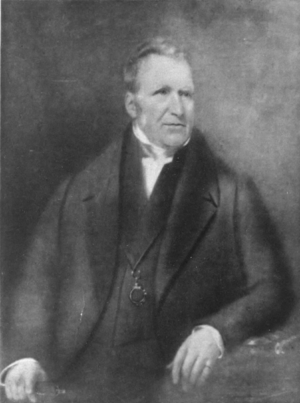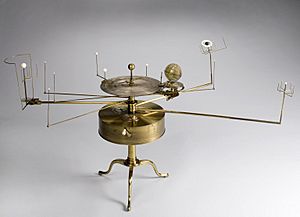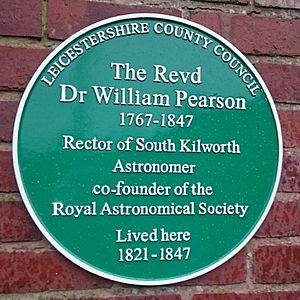William Pearson (astronomer) facts for kids
William Pearson (born April 23, 1767 – died September 6, 1847) was an English teacher and astronomer. He helped start the Astronomical Society of London. He also wrote an important two-volume book called Practical Astronomy in 1825 and 1829.
Contents
William Pearson's Life Story
William Pearson was born in a place called Whitbeck in Cumberland, England. This was on April 23, 1767. After finishing school at Hawkshead Grammar School, he became a teacher there.
Later, he moved to Lincoln to teach at the Free Grammar School. William loved astronomy. He even built a special clock that showed how planets move. He also made an orrery, which is a model of the solar system. He probably used these for public talks.
Early Career and Astronomy
William Pearson became a member of the Royal Institution in London. In 1803, he finished building a planetarium. This was a device that showed how planets move. It was used for lectures by a scientist named Thomas Young.
In 1810, William became the rector (a type of church leader) of Perivale in Middlesex. He also bought a large private school called Temple Grove School in East Sheen.
Building Observatories
At his school in East Sheen, William built an observatory. This is a place with telescopes to watch the sky. In 1820, he used a special tool to measure the sizes of the Sun and Moon. He did this during a partial solar eclipse.
William Pearson was very important in starting the Astronomical Society of London. This group is now known as the Royal Astronomical Society. He began working on the idea for the society in 1812 and 1816.
The society officially started at a meeting on January 12, 1820. William helped write the rules for the group. He also served as its treasurer for the first ten years. In 1819, he became a Fellow of the Royal Society. This is a big honor for scientists.
In 1821, William left East Sheen. He then built another observatory at South Kilworth. This observatory had several powerful telescopes. One telescope was 36 inches long. It was first built for the St. Petersburg Academy of Sciences.
His observatory also had a 42-inch telescope and a special clock. These tools helped him study the stars and planets.
Important Astronomical Work
While at South Kilworth, William Pearson watched the Pleiades star cluster. He observed when the Moon passed in front of these stars in 1821.
In 1824 and 1829, he published his two-volume book, Introduction to Practical Astronomy. The first book had tables for calculations. The second book had detailed drawings and instructions for using different astronomical tools.
For this important book, William received the Gold Medal of the Royal Astronomical Society in 1829. A famous astronomer, Sir John Herschel, called it a very important work.
In 1830, William was chosen to be on the new board of visitors for the Royal Observatory. With help from a local mathematician, he started checking and calculating the positions of 520 stars. He presented this new list of stars to the Royal Astronomical Society in 1841.
William Pearson also observed Halley's Comet in 1835. In 1839, he calculated the tilt of Earth's axis from his own research. He passed away on September 6, 1847, in South Kilworth. A plaque in the church honors him for his good work as a clergyman and judge.
William Pearson's Family
William Pearson married Frances Low on February 22, 1796. They had a daughter named Frances in 1797. Frances Pearson, William's first wife, died in 1831 at age 61. She was buried in South Kilworth.
He married Eliza Sarah Hunter on November 10, 1832. Eliza Sarah Pearson died in 1878 at age 82.
William Pearson's Writings
- His textbook, Selected Speeches for the Young Gentlemen of the Seminary (1801), taught students how to speak well.
- His book, Introduction to Practical Astronomy, had two volumes. Volume 1 was from 1824, and Volume 2 was from 1829. It included 31 detailed drawings of astronomical tools.
- Pearson wrote 63 articles for Rees's Cyclopædia. These articles were about practical astronomy, including instruments, clocks, and planetary machines.
- He also wrote an article about planetary machines for the Edinburgh Encyclopædia.
- He wrote many articles for other science magazines. These included Nicholson's Journal and the Philosophical Magazine.
Honoring William Pearson
On January 16, 2020, a special green plaque was put up at the Rectory in South Kilworth, Leicestershire. This is where William Pearson lived from 1821 until he died in 1847.
This event happened just four days after the 200th anniversary of the meeting that started the Astronomical Society of London. That meeting was on January 12, 1820. The society later became the Royal Astronomical Society in 1831.
William Pearson's grave was also fixed up in 2019. This was done with money from the local council and the Royal Astronomical Society.




